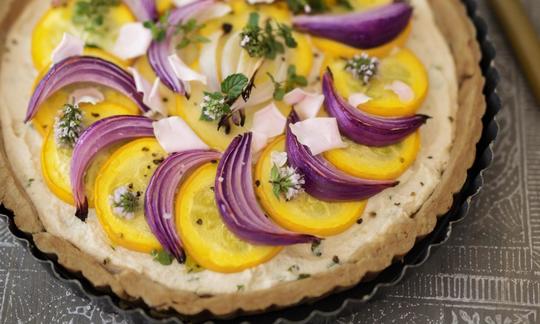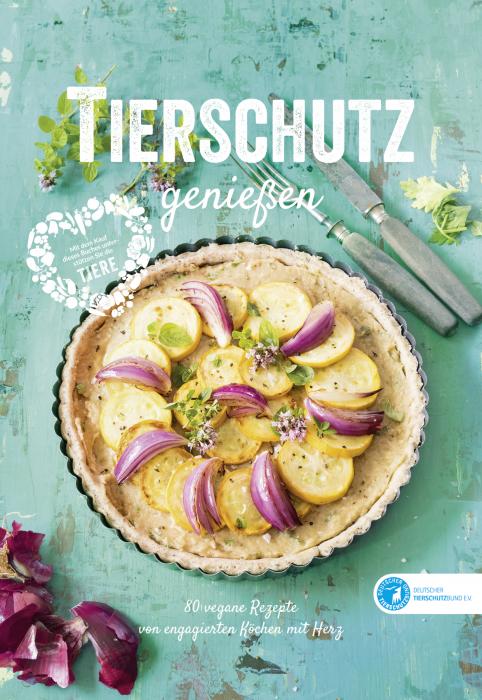Zucchini and Onion Quiche with a Cashew Sauce
vegan
Ingredients (for servings, )
Equipment
- hand-held blender / immersion blender or blender
- baking pan (springform pan)
- skillet (frying pan)
- stove
- coffee grinder, electric
- oven
Type of preparation
- bake
- chop or grind
- dry roast
- purée
- remove the skin
Preparation
For the crust
Preheat the oven to 200 °C (or 180 °C in a convection oven; gas oven: gas mark 6). For the crust, toast the pine nuts in a dry pan until golden brown. Let cool and then coarsely chop. Mix the pine nuts with the flour, flaxseed, salt, pepper, and baking powder.You can also use whole wheat flour instead of whole grain spelt flour. The original recipe calls for ground flaxseed, and we recommend that you use this. If you grind it yourself, coarsely ground flaxseed is good enough.
We have cut the amount of salt that is called for in the original recipe in half. See “Tips.”
Whisk the flaxseed oil and 200 mL lukewarm water and add to the dry ingredients. Stir with the handle of a wooden spoon until the ingredients are combined.
We have also cut the amount of flaxseed oil in half.
Line a pie or springform pan (26 cm) with parchment paper (or grease). Then line the pan with the dough, creating a 2 cm tall rim around the edge of the pan. Prick the crust with a fork and bake in the oven for 5 minutes.
For the topping
While the crust is in the oven, wash the (yellow) zucchini and cut into 1 mm thick slices. Peel the onions and cut into wedges or slices.The original recipe specifies using yellow zucchini.
For 4 servings, use 2 medium red onions.
For the filling
Rinse the herbs, shake to remove excess moisture, remove the leaves, and finely chop. Puree the cashews with the yeast flakes, salt, vinegar, and 200 mL water. Stir in the herbs.The author uses cashew butter instead of cashews. We recommend gradually adding the cashews as you puree the filling, or adding more water if the filling is too thick.
You can also use white wine vinegar instead of apple cider vinegar.
Finishing the quiche
If the crust has risen in the oven, press down slightly with a paper towel. Pour the filling into the crust and spread evenly. Alternately layer the zucchini slices and onion wedges so that they are slightly overlapping.
Sprinkle the quiche with a pinch of salt. Bake at the same temperature for another 45 minutes.Seasoning and serving
Garnish the quiche with fresh basil and edible flowers (optional). Season to taste with freshly ground black pepper.The original recipe for 4 servings calls for 3 sprigs of basil.
Mint flowers are an example of an edible flower that you could use to garnish your quiche.
|
Nutritional Information per person
Convert per 100g
|
2000 kcal | |
|---|---|---|
| Energy | 537 kcal | 26.9% |
| Fat/Lipids | 27 g | 39.2% |
| Saturated Fats | 3.5 g | 17.4% |
| Carbohydrates (inc.dietary fiber) | 63 g | 23.4% |
| Sugars | 5.6 g | 6.2% |
| Fiber | 10 g | 40.4% |
| Protein/Albumin | 18 g | 35.1% |
| Cooking Salt (Na:724.3 mg) | 1'840 mg | 76.7% |
| Essential micronutrients with the highest proportions | per person | 2000 kcal | |
|---|---|---|---|
| Fat | Alpha-Linolenic acid; ALA; 18:3 omega-3 | 5.0 g | 251.0% |
| Min | Manganese, Mn | 3.6 mg | 183.0% |
| Min | Copper, Cu | 1.1 mg | 110.0% |
| Vit | Vitamin B1 (Thiamine) | 1.1 mg | 102.0% |
| Sodium, Na | 724 mg | 91.0% | |
| Prot | Tryptophan (Trp, W) | 0.21 g | 85.0% |
| Elem | Phosphorus, P | 500 mg | 71.0% |
| Min | Iron, Fe | 9.5 mg | 68.0% |
| Prot | Threonine (Thr, T, irreversibly transaminated) | 0.56 g | 60.0% |
| Fat | Linoleic acid; LA; 18:2 omega-6 | 6.0 g | 60.0% |
Detailed Nutritional Information per Person for this Recipe
The majority of the nutritional information comes from the USDA (US Department of Agriculture). This means that the information for natural products is often incomplete or only given within broader categories, whereas in most cases products made from these have more complete information displayed.
If we take flaxseed, for example, the important essential amino acid ALA (omega-3) is only included in an overarching category whereas for flaxseed oil ALA is listed specifically. In time, we will be able to change this, but it will require a lot of work. An “i” appears behind ingredients that have been adjusted and an explanation appears when you hover over this symbol.
For Erb Muesli, the original calculations resulted in 48 % of the daily requirement of ALA — but with the correction, we see that the muesli actually covers >100 % of the necessary recommendation for the omega-3 fatty acid ALA. Our goal is to eventually be able to compare the nutritional value of our recipes with those that are used in conventional western lifestyles.
| Essential fatty acids | per person | 2000 kcal |
|---|---|---|
| Alpha-Linolenic acid; ALA; 18:3 omega-3 | 5.0 g | 251.0% |
| Linoleic acid; LA; 18:2 omega-6 | 6.0 g | 60.0% |
| Essential amino acids | per person | 2000 kcal |
|---|---|---|
| Tryptophan (Trp, W) | 0.21 g | 85.0% |
| Threonine (Thr, T, irreversibly transaminated) | 0.56 g | 60.0% |
| Phenylalanine (Phe, F) | 0.80 g | 52.0% |
| Isoleucine (Ile, I) | 0.64 g | 51.0% |
| Valin (Val, V) | 0.80 g | 49.0% |
| Leucine (Leu, L) | 1.2 g | 48.0% |
| Lysine (Lys, K, irreversibly transaminated) | 0.57 g | 31.0% |
| Methionine (Met, M) | 0.27 g | 29.0% |
| Vitamins | per person | 2000 kcal |
|---|---|---|
| Vitamin B1 (Thiamine) | 1.1 mg | 102.0% |
| Vitamin K | 44 µg | 58.0% |
| Vitamin B9, B11 (Folate, as the active form of folic acid) | 75 µg | 37.0% |
| Vitamin B6 (pyridoxine) | 0.43 mg | 31.0% |
| Vitamin B3 (Niacin) | 4.2 mg | 26.0% |
| Vitamin B5 (Pantothenic acid) | 1.3 mg | 22.0% |
| Vitamin C (ascorbic acid) | 15 mg | 19.0% |
| Vitamin B7 (Biotin, ex vitamin H) | 9.7 µg | 19.0% |
| Vitamin E, as a-TEs | 2.2 mg | 18.0% |
| Vitamin B2 (Riboflavin) | 0.16 mg | 11.0% |
| Vitamin A, as RAE | 30 µg | 4.0% |
| Essential macroelements (macronutrients) | per person | 2000 kcal |
|---|---|---|
| Sodium, Na | 724 mg | 91.0% |
| Phosphorus, P | 500 mg | 71.0% |
| Magnesium, Mg | 197 mg | 52.0% |
| Potassium, K | 725 mg | 36.0% |
| Calcium, Ca | 71 mg | 9.0% |
| Essential trace elements (micronutrients) | per person | 2000 kcal |
|---|---|---|
| Manganese, Mn | 3.6 mg | 183.0% |
| Copper, Cu | 1.1 mg | 110.0% |
| Iron, Fe | 9.5 mg | 68.0% |
| Zinc, Zn | 4.7 mg | 47.0% |
| Selenium, Se | 5.8 µg | 11.0% |
| Fluorine, F | 73 µg | 2.0% |
| Iod, I (Jod, J) | 2.8 µg | 2.0% |
Neun Zehn Verlag , Dtsch.Tierschutzbund
Raw recipes 7 (1), Cooked recipes 78 (2)
Additional photos (8)
The book "Enjoying Animal Welfare – 80 Vegan Recipes from Dedicated Chefs with Heart" proves how simple, diverse, and exciting vegan dishes can be.
Since this book is written in German, a description is omitted here. If you are interested, please switch to German in the menu.
The crust of this zucchini and onion quiche with cashew sauce is made from whole wheat flour and pine nuts. Fresh herbs give this dish a special flavor.
Spelt flour: Spelt flour is closely related to wheat and is often referred to as “proto-wheat.” Both whole grain and white spelt flour are available in stores. While all types of spelt flour are a good source of minerals, whole grain spelt flour has a higher nutrient content and is a healthier choice. White spelt flour (type 630) is mainly used for baking and in most recipes can be used as a substitute for wheat flour. The nutrient content of spelt is comparable to that of wheat, with the exception of silica. Spelt flour contains significantly higher levels of this nutrient than does wheat flour.
Flaxseed oil: Also known as linseed oil, is obtained from the seeds of the flax plant (Linum usitatissimum). Cold-pressed flaxseed oil has a distinctive flavor that is crisp, clean, and mildly nutty. It is golden yellow in color. Cold-pressed flaxseed oil is a good source of omega-3 fatty acids, but it oxidizes quickly and can only be stored for a very short time. The ratio of linoleic acid (omega-6 fatty acids) to alpha-linolenic acid (omega-3 fatty acids) in flaxseed oil is about 1:3–1:4.
Zucchini: Zucchini is a versatile vegetable that can be eaten fresh or cooked. Green zucchini is the most common type of zucchini; however, golden zucchini is becoming increasingly available in supermarkets. In terms of flavor, there is hardly any difference between zucchini varieties. Zucchini is easy to digest, low in calories, and rich in vitamins. You shouldn’t eat zucchini that tastes bitter because this can be an indication of the presence of toxic bitter substances (cucurbitacins), which can attack the gastrointestinal mucosa. When growing your own zucchini, you should make sure to neither cross-pollinate them using your own seeds nor cross zucchini with other squash as this can result in a higher content of toxic bitter substances that cannot be removed through cooking.
Reducing salt and oil: We have intentionally reduced the amount of salt. The goal is to keep the salt content as low as possible without sacrificing flavor. Since the amount of salt required varies by individual, it is best for you to decide on the amount to use. We have also reduced the amount of oil. We recommend the book Salt Sugar Fat by Michael Moss, which provides interesting insight into this topic.
Springform pan size: You will get the best results by using a 26 cm (10 inch) springform pan.




